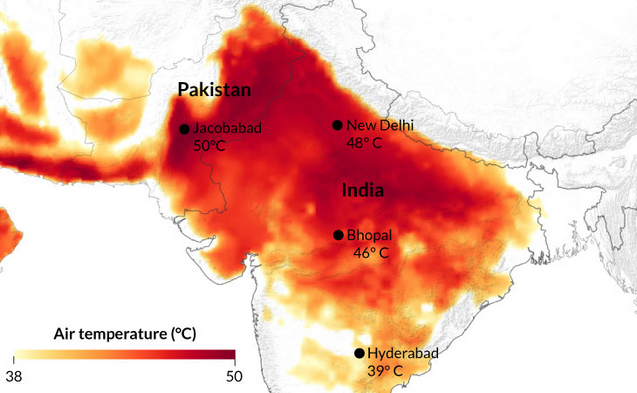The window to prevent the worst of it is closing. Fast.
 |
ARUN SANKAR Getty Images
|
It is a long held belief here in the shebeen
that, thanks to those clever Chinese climate hoaxsters, the next world
wars are going to be fought not over oil, but over water.
This is
especially true in places like India, which is currently in the middle of a murderous heat wave
in which temperatures regularly top out at 120 degrees Fahrenheit, and
where hugely populated cities are running out of water. From the BBC:
Residents have had to stand in line for hours to get water from government tanks, and restaurants have closed due to the lack of water. "Only rain can save Chennai from this situation," an official told BBC Tamil.
The city, which, according to the 2011 census, is India's sixth largest, has been in the grip of a severe water shortage for weeks now.
As the reservoirs started to run dry, many hotels and restaurants shut down temporarily.
The Chennai metro has turned off air conditioning in the stations, while offices have asked staff to work from home in a bid to conserve water...
The water crisis has also meant that most of the city has to depend solely on Chennai's water department, which has been distributing water through government trucks across neighborhoods.
"The destruction has just begun," an official said. "If the rain fails us this year too, we are totally destroyed."
And, as the Times of London
reports, the combination of heat and drought not only is killing
people, but also is emptying villages in the northern part of India.
(Gee, I wonder where everyone will go and how welcome they'll be when
they get there?) And things among the people who have stayed so far are
getting ugly.
In the worst-hit areas many villages starved of water have been abandoned until the arrival of the monsoon brings relief, after weeks of temperatures topping 50 degrees.Forbes:
In the northern states of Uttar Pradesh, Bihar and Rajasthan fighting has broken out over scarce water supplies, with police deployed to protect water trucks and wells.
"We have exquisite information about what that state is, because we have a paleo record going back millions of years, when the earth had no ice at either pole. There was almost no temperature difference between the equator and the pole," said James Anderson, a Harvard University professor of atmospheric chemistry best known for establishing that chlorofluorocarbons were damaging the Ozone Layer.No system of government devised by human beings can withstand what's coming, any more than overbuilt coastal enclaves can.
"The ocean was running almost 10ºC warmer all the way to the bottom than it is today," Anderson said of this once-and-future climate, "and the amount of water vapor in the atmosphere would have meant that storm systems would be violent in the extreme, because water vapor, which is an exponential function of water temperature, is the gasoline that fuels the frequency and intensity of storm systems."...
People have the misapprehension that we can recover from this state just by reducing carbon emissions, Anderson said in an appearance at the University of Chicago.
Recovery is all but impossible, he argued, without a World War II-style transformation of industry—an acceleration of the effort to halt carbon pollution and remove it from the atmosphere, and a new effort to reflect sunlight away from the earth's poles.
This has to be done, Anderson added, within the next five years.
"The chance that there will be any permanent ice left in the Arctic after 2022 is essentially zero," Anderson said, with 75 to 80 percent of permanent ice having melted already in the last 35 years.
Links
- Chennai water crisis: City's reservoirs run dry - BBC News
- Tens of Thousands Flee Extreme Heatwave in India as Temperatures Topping 120°F Kill Dozens Across Country
- Thousands abandon villages in India to escape record 50 degree heat wave
- We Have Five Years To Save Ourselves From Climate Change, Harvard Scientist Says


















